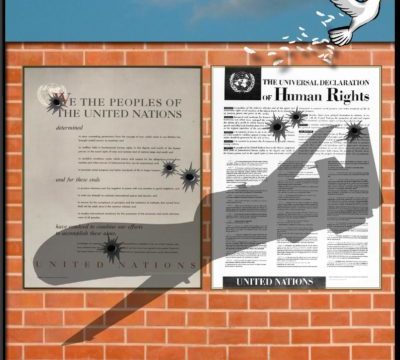Al hassane Faty
Cheikh Anta Diop University of Dakar (UCAD) – SENEGAL
Introduction
Maintaining and strengthening quality education is essential to combat humanitarian crises. Education is not given enough priority by humanitarian interventions and emergencies (wars, epidemics, natural disasters…). Emergency education must be a pillar of humanitarian aid.
Also beyond learning, education supports some of the overarching goals of humanitarian aid such as protection, support, social services and familiarity.
Thus, Inter Agency Emergency Network is gathering non-governmental organizations, governments and United Nations’ agencies work together to ensure the right to education in emergencies and in the early stages of construction, food, housing, health etc. However, it is recognized that humanitarian aid should consider the overall well-being of human beings.
On September 02, 1990, twenty states marked the vigor of the International Convention on the Rights of the child, adopted on July 11 by the Organization of the African Unity which became the African Union (the African Charts of Rights and Welfare). However, it remains to apply it, to transform words into actions, to make words a reality.
Safe Schools Declaration’s Commitments has limits, since „one in 10 lives in a country or zone affected by armed confl ict are children, and one in four of these children do not go to school“ (unicef.fr), temporary learning schools are to be welcomed and encouraged given that education allows a return to normality and instills hope in the future.
Chapter I: Recognition of Children’s Rights
The Global Partnership for Education works for more than 65 developing countries to strengthen their education systems, so that all children, regardless of economic status, gender, disability or wherever they live, can go to school and benefi t from learning. However, more than 260 million children are out of school and twothirds of school children will finish primary school without knowing how to read.
The main issues facing children are:
The war
In armed confl icts, children are often deliberately targeted or not adequately protected. In Mali, children have suffered greatly from the crisis due to the displacement, violence, sexual abuse, loss of or separation from family members and their recruitment into armed forces or groups. Among other traumatic events and stressors is the deprivation of the right to education by certain actors. And if education is under attack, UNICEF should be:
„on the frontlines in confl ict-affected countries to develop school safety plans, get children back to learning by providing psycho-social and informal learning opportunities, training teachers, rehabilitating schools and distributing supplies for teaching and learning“ (unicef.org).
All of these are factors of hopelessness, demoralization, anxiety and general psychological distress.
In addition, sexual violence against civilian populations has become a feature of conflicts. The fear of such violence, which increases when the perpetrators are not held accountable for
their actions, has the effect of weakening vulnerable populations. This can restrict the mobility of girls and women and may induce them to stay at home and avoid going to school.
Education
Schools can be seen as an embodiment of state authority; therefore, they are considered legitimate military targets by non-state actors.
Poverty and Child Labor
The international trade sanctions imposed because of anti-regime protests have had a signifi cant negative impact on the socio-economic situation of the civilian population. These sanctions limit state revenues, further limiting the resources available to pay public sector workers. This causes a significant reduction in the income of several families.
Child labor is generally a neglected issue in humanitarian crises. Working children, especially those involved in the worst forms of child labor, are often invisible and excluded from humanitarian assistance.
Chapter II: Safe Schools Declaration
To protect schools and universities, the Safe Schools Declaration was initiated in 2015 in Geneva. It urges signatory states (56) to follow the following recommendations:
– Refrain from using schools and universities in their military efforts,
– Do not seek to destroy or damage schools or universities,
– Use force only as a last resort and consider all alternatives. (unicef.fr)
We do not know this enough but schools do not enjoy the same level of protection as those granted to hospitals and international humanitarian assistance: if the international conventions do indeed prohibit deliberately attacking a school…they do not prohibit that it be occupied by armed forces.
However, a school used for military purposes not only deprives children of their fundamental right to education… but even becomes a „target“ for attacks.
This is why UNICEF France had asked Francois Hollande and the French government to commit to signing this text (2017) – and thus become the first member of the United Nations
Security Council to do so. The Haitian scholar Lefabson Sully even suggested that „a course of rights and duties of children must be included in the curriculum offered by the ministries of education“ (www.washingtonpost.com)
In Syria and its neighbouring countries, Syrian children have been forced to become ‘‘breadwinners“ of their families. Education systems have been the target of attacks in Syria, as armed groups have seen military strategies targeting schools, school children and teachers.
In 2016, UNICEF reported that 2.1 million children in Syria and 700 000 Syrian refugee children do not have access to education. Among Syrian refugee children in Jordan in 2016, more than 80 000 were out of school (Human Rights Watch).
Chapter III: Temporary Learning species
During the Ebola crisis in Sierra Leone, the Ministry of Education was able to continue teaching during radio program while the schools were closed for almost a year. In Afghanistan, the state has recognized that commuting to school is often dangerous in times of crises and has therefore established community schools.
Nevertheless, the organization of the space must allow fl exibility of use during these different periods and these different times. The space must respond to the evolution of the use of premises, over time. Based on the words of Helena Murseli who believes that: „the process of setting up temporary learning spaces consist first of all identifying the places, in or near displacement camps, then proceeding to the opening of these spaces, conditioned on the supply of materials.“ (unicef.org)
Bibliography
UNICEF FOR EVERY CHILD. „Education Under Attack“. https://www.unicef.org/education-under-attack „Students are trashing Hunger, not Food„. September 2017. www.foodtank.com
DEWEY, Caitlin. April 2018.“The Hidden Crisis on College Campuses : Many students Don’t Have enough to Eat“. www.washingtonpost.com.
Schools & Health. April-2020. „Malaria“. www.schoolsandhealth.org
SUBSAHARIAN-AFRICA VOLUME 2. September 2016. „Education in Emergencies and Protracted Crises in Sub-Saharian Africa“. www.onusenegal.org
MURSELI, Helena. 2019. «L’éducation en situation de conflit en République Centre Africaine.» https://journals.openedition.org/cres/4009
NGONGO, Kazembe. 2014. «La protection des enfants pendant les confl its armés, cas de l’est de la RDC, de 1996 à 2015» par Constantin Université de Kinshasa – Graduat
SULLY, Lefabson. 2005. Protection «Plaidoyer pour la protection des droits de l’enfant en Haïti». www.memoireonline.com
article/ «des-ecoles-pas-des-champs-de-bataillela-france-doit-signer-la-declaration-de-securite»-https://www.unicef.fr/










